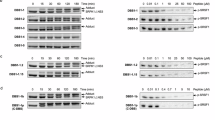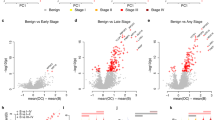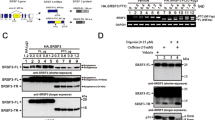Abstract
By using the positional cloning gene approach, we were able to identify a novel gene encoding for a serine/arginine-rich protein, which appears to be the human homologue of the rat A1 gene. We named this new gene SR-A1. Members of the SR family of proteins have been shown to interact with the C-terminal domain (CTD) of the large subunit of RNA polymerase II and participate in pre-mRNA splicing. We have localized the SR-A1 gene between the known genes IRF3 and RRAS on chromosome 19q13.3. The novel gene spans 16.7 kb of genomic sequence and it is formed of 11 exons and 10 intervening introns. The SR-A1 protein is composed of 1312 amino acids, with a molecular mass of 139.3 kDa and a theoretical isoelectric point of 9.31. The SR-A1 protein contains an SR-rich domain as well as a CTD-binding domain present only in a subset of SR-proteins. Through interactions with the pre-mRNA and the CTD domain of the Polymerase II, SR proteins have been shown to regulate alternative splicing. The SR-A1 gene is expressed in all tissues tested, with highest levels found in fetal brain and fetal liver. Our data suggest that this gene is overexpressed in a subset of ovarian cancers which are clinically more aggressive. Studies with the steroid hormone receptor-positive breast and prostate carcinoma cell lines ZR-75-1, BT-474 and LNCaP, respectively, suggest that SR-A1 is constitutively expressed. Furthermore, the mRNA of the SR-A1 gene in these cell lines appears to increase by estrogens, androgens and glucocorticoids, and to a lesser extend by progestins. © 2001 Cancer Research Campaign www.bjcancer.com
Similar content being viewed by others
Article PDF
Change history
16 November 2011
This paper was modified 12 months after initial publication to switch to Creative Commons licence terms, as noted at publication
References
Aiyar A (2000) The use of CLUSTAL W and CLUSTAL X for multiple sequence alignment. Methods Mol Biol 132: 221–241
Altschul SF, Madden TL, Schaffer AA, Zhang J, Zhang Z, Miller W and Lipman DJ (1997) Gapped BLAST and PSI-BLAST: a new generation of protein database search programs. Nucleic Acids Res 25: 3389–3402
Amrein H, Gorman M and Nothiger R (1988) The sex-determining gene tra-2 of Drosophila encodes a putative RNA binding protein [published erratum appears in Cell 1989 Jul 28;58(2): following 419]. Cell 55: 1025–1035
Ashworth LK, Batzer MA, Brandriff B, Branscomb E, de Jong P, Garcia E, Garnes JA, Gordon LA, Lamerdin JE and Lennon G (1995) An integrated metric physical map of human chromosome 19. Nat Genet 11: 422–427
Au WC, Moore PA, Lowther W, Juang YT and Pitha PM (1995) Identification of a member of the interferon regulatory factor family that binds to the interferon-stimulated response element and activates expression of interferon-induced genes. Proc Natl Acad Sci USA 92: 11657–11661
Bairoch A, Bucher P and Hofmann K (1997) The PROSITE database, its status in 1997. Nucleic Acids Res 25: 217–221
Blencowe BJ, Nickerson JA, Issner R, Penman S and Sharp PA (1994) Association of nuclear matrix antigens with exon-containing splicing complexes. J Cell Biol 127: 593–607
Brendel V, Bucher P, Nourbakhsh IR, Blaisdell BE and Karlin S (1992) Methods and algorithms for statistical analysis of protein sequences. Proc Natl Acad Sci USA 89: 2002–2006
Cannistra SA, Kansas GS, Niloff J, DeFranzo B, Kim Y and Ottensmeier C (1993) Binding of ovarian cancer cells to peritoneal mesothelium in vitro is partly mediated by CD44H. Cancer Res 53: 3830–3838
Cavaloc Y, Popielarz M, Fuchs JP, Gattoni R and Stevenin J (1994) Characterization and cloning of the human splicing factor 9G8: a novel 35 kDa factor of the serine/arginine protein family. Embo J 13: 2639–2649
Day TG Jr, Gallager HS and Rutledge FN (1975) Epithelial carcinoma of the ovary: prognostic importance of histologic grade. Natl Cancer Inst Monogr 42: 15–21
Fu XD and Maniatis T (1992) Isolation of a complementary DNA that encodes the mammalian splicing factor SC35. Science 256: 535–538
Ge H, Zuo P and Manley JL (1991) Primary structure of the human splicing factor ASF reveals similarities with Drosophila regulators. Cell 66: 373–382
Gobert C, Bracco L, Rossi F, Olivier M, Tazi J, Lavelle F, Larsen AK and Riou JF (1996) Modulation of DNA topoisomerase I activity by p53. Biochemistry 35: 5778–5786
Goralski TJ, Edstrom JE and Baker BS (1989) The sex determination locus transformer-2 of Drosophila encodes a polypeptide with similarity to RNA binding proteins. Cell 56: 1011–1018
Hansen JE, Lund O, Tolstrup N, Gooley AA, Williams KL and Brunak S (1998) NetOglyc: prediction of mucin type of O-glycosylation sites based on sequence context and surface accessibility. Glycoconj J 15: 115–130
Hoffmann K and Stoffel W (1992) PROFILEGRAPH: an interactive graphical tool for protein sequence analysis. Comput Appl Biosci 8: 331–337
Iida Y (1990) Quantification analysis of 5′-splice signal sequences in mRNA precursors. Mutations in 5′-splice signal sequence of human beta-globin gene and beta-thalassemia. J Theor Biol 145: 523–533
Kim H, Scorilas A, Katsaros D, Yousef GM, Massobrio M, Fracchioli S, Piccinno R, Gordini G and Diamandis EP (2001) Human kallikrein gene 5 (KLK5) expression is an indicator of poor prognosis in ovarian cancer. Br J Cancer 84: 643–650
Kim YJ, Zuo P, Manley JL and Baker BS (1992) The Drosophila RNA-binding protein RBPI is localized to transcriptionally active sites of chromosomes and shows a functional similarity to human splicing factor ASF/SF2. Genes Dev 6: 2569–2579
Kohtz JD, Jamison SF, Will CL, Zuo P, Luhrmann R, Garcia-Blanco MA and Manley JL (1994) Protein-protein interactions and 5′-splice-site recognition in mammalian mRNA precursors. Nature 368: 119–124
Kozak M (1991) An analysis of vertebrate mRNA sequences: intimations of translational control. J Cell Biol 115: 887–903
Lennon G, Auffray C, Polymeropoulos M and Soares MB (1996) The I.M.A.G.E. Consortium: an integrated molecular analysis of genomes and their expression. Genomics 33: 151–152
Lowther WJ, Moore PA, Carter KC and Pitha PM (1999) Cloning and functional analysis of the human IRF-3 promoter. DNA Cell Biol 18: 685–692
McKeown M, Belote JM and Baker BS (1987) A molecular analysis of transformer, a gene in Drosophila melanogaster that controls female sexual differentiation. Cell 48: 489–499
Meier UT (1996) Comparison of the rat nucleolar protein nopp 140 with its yeast homolog SRP40. Differential phosphorylation in vertebrates and yeast. J Biol Chem 271: 19376–19384
Murakami K and Takagi T (1998) Gene recognition by combination of several gene-finding programs. Bioinformatics 14: 665–675
Nielsen H, Brunak S and von Heijne G (1999) Machine learning approaches for the prediction of signal peptides and other protein sorting signals. Protein Eng 12: 3–9
Pettersson F (1994) Annual report on the treatment in gynecological cancer. Stocklolm,International Federation of Gynecology and Obstetrics 22,
Retief JD (2000) Phylogenetic analysis using PHYLIP. Methods Mol Biol 132: 243–258
Ruegsegger U, Blank D and Keller W (1998) Human pre-mRNA cleavage factor Im is related to spliceosomal SR proteins and can be reconstituted in vitro from recombinant subunits. Mol Cell 1: 243–253
Scorilas A, Black MH, Talieri M and Diamandis EP (2000) Genomic organization, physical mapping, and expression analysis of the human protein arginine methyltransferase 1 gene. Biochem Biophys Res Commun 278: 349–359
Scorilas A, Kyriakopoulou L, Yousef G, Ashworth L, Kwamie A and Diamandis E (2001) Molecular cloning, physical mapping and expression analysis of a novel gene, BCL2L12, encoding for a proline-rich protein with a highly conserved BH2 domain of the Bcl-2 family. Genomics 73,
Screaton GR, Caceres JF, Mayeda A, Bell MV, Plebanski M, Jackson DG, Bell JI and Krainer AR (1995) Identification and characterization of three members of the human SR family of pre-mRNA splicing factors. Embo J 14: 4336–4349
Serov SF and Sorbin LH (1973). Histological typing of ovarian tumors. No.9, Geneva,World Helth Organization 17,
Spritz RA, Strunk K, Surowy CS, Hoch SO, Barton DE and Francke U (1987) The human U1-70K snRNP protein: cDNA cloning, chromosomal localization, expression, alternative splicing and RNA-binding. Nucleic Acids Res 15: 10373–10391
Stickeler E, Kittrell F, Medina D and Berget SM (1999) Stage-specific changes in SR splicing factors and alternative splicing in mammary tumorigenesis. Oncogene 18: 3574–3582
Surowy CS, Hoganson G, Gosink J, Strunk K and Spritz RA (1990) The human RD protein is closely related to nuclear RNA-binding proteins and has been highly conserved. Gene 90: 299–302
Takagaki Y, Ryner LC and Manley JL (1989) Four factors are required for 3′-end cleavage of pre-mRNAs. Genes Dev 3: 1711–1724
Takagaki Y, MacDonald CC, Shenk T and Manley JL (1992) The human 64-kDa polyadenylylation factor contains a ribonucleoprotein-type RNA binding domain and unusual auxiliary motifs. Proc Natl Acad Sci USA 89: 1403–1407
Takezaki N (1998) Tie trees generated by distance methods of phylogenetic reconstruction. Mol Biol Evol 15: 727–737
Tanner S, Stagljar I, Georgiev O, Schaffner W and Bourquin JP (1997) A novel SR-related protein specifically interacts with the carboxy-terminal domain (CTD) of RNA polymerase II through a conserved interaction domain. Biol Chem 378: 565–571
Vellard M, Sureau A, Soret J, Martinerie C and Perbal B (1992) A potential splicing factor is encoded by the opposite strand of the trans-spliced c-myb exon. Proc Natl Acad Sci USA 89: 2511–2515
Wang J, Xiao SH and Manley JL (1998) Genetic analysis of the SR protein ASF/SF2: interchangeability of RS domains and negative control of splicing. Genes Dev 12: 2222–2233
Webb CP, Van Aelst L, Wigler MH and Woude GF (1998) Signaling pathways in Rasmediated tumorigenicity and metastasis. Proc Natl Acad Sci USA 95: 8773–8778
Yousef GM, Chang A, Scorilas A and Diamandis EP (2000a) Genomic organization of the human kallikrein gene family on chromosome 19q 13.3-q 13.4. Biochem Biophys Res Commun 276: 125–133
Yousef GM, Scorilas A and Diamandis EP (2000b) Genomic organization, mapping, tissue expression, and hormonal regulation of trypsin-like serine protease (TLSP PRSS20), a new member of the human kallikrein gene family. Genomics 63: 88–96
Yousef GM, Scorilas A, Magklara A, Soosaipillai A and Diamandis EP (2000c) The KLK7 (PRSS6) gene, encoding for the stratum corneum chymotryptic enzyme is a new member of the human kallikrein gene family – genomic characterization, mapping, tissue expression and hormonal regulation. Gene 254: 119–128
Yousef GM, Scorilas A, Jung K, Ashworth LK and Diamandis EP (2001) Molecular cloning of the human kallikrein 15 gene (KLK15). Up-regulation in prostate cancer. J Biol Chem 276: 53–61
Yuryev A, Patturajan M, Litingtung Y, Joshi RV, Gentile C, Gebara M and Corden JL (1996) The C-terminal domain of the largest subunit of RNA polymerase II interacts with a novel set of serine/argine-rich proteins. Proc Natl Acad Sci USA 93: 6975–6980
Zahler AM, Neugebauer KM, Stolk JA and Roth MB (1993) Human SR proteins and isolation of a cDNA encoding SRp75. Mol Cell Biol 13: 4023–4028
Author information
Authors and Affiliations
Rights and permissions
From twelve months after its original publication, this work is licensed under the Creative Commons Attribution-NonCommercial-Share Alike 3.0 Unported License. To view a copy of this license, visit http://creativecommons.org/licenses/by-nc-sa/3.0/
About this article
Cite this article
Scorilas, A., Kyriakopoulou, L., Katsaros, D. et al. Cloning of a gene (SR-A1), encoding for a new member of the human Ser/Arg-rich family of pre-mRNA splicing factors: overexpression in aggressive ovarian cancer. Br J Cancer 85, 190–198 (2001). https://doi.org/10.1054/bjoc.2001.1885
Received:
Revised:
Accepted:
Published:
Issue date:
DOI: https://doi.org/10.1054/bjoc.2001.1885
Keywords
This article is cited by
-
A statistical method for predicting splice variants between two groups of samples using GeneChip® expression array data
Theoretical Biology and Medical Modelling (2006)



